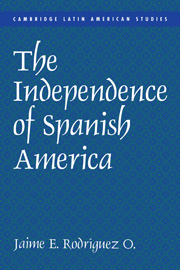Preface
Published online by Cambridge University Press: 05 October 2013
Summary
Although the Spanish language version of this work, La independencia de la América española, was written between 1993 and 1995, in one way or another I have been working on the subject for nearly a quarter of a century. My first book, The Emergence of Spanish America: Vicente Rocafuerte and Spanish Americanism, 1808–1832 (Berkeley: University of California Press, 1975), examined some aspects of the period. Chapter 1, entitled “The Spanish Heritage,” considered the Bourbon reforms and the first constitutional period (1810–14), and chapter 2 dealt with “The Spanish Constitution Restored.” In that work, I first advanced the notions that a revolution had occurred within the Spanish world and that Spanish American leaders initially “had favored the creation of a constitutional Hispanic commonwealth. But the subsequent failure of the Spanish Cortes (1810–1814 and 1820-1823) forced” them to seek independence.
Since the time of that work, I have become intrigued by the process of nation building. In particular, I was perplexed by the question of why one former colony, the United States, established a stable government and developed economically, whereas the other former colonies, the Spanish American countries, endured political chaos and economic decline during the nineteenth century. I therefore began two separate studies, one of Ecuador – the former Kingdom of Quito – and the other of Mexico – the former Viceroyalty of New Spain – in an effort to understand how those two very different regions made the transition from kingdoms of the Spanish Monarchy to independent nations.
- Type
- Chapter
- Information
- The Independence of Spanish America , pp. xi - xivPublisher: Cambridge University PressPrint publication year: 1998

